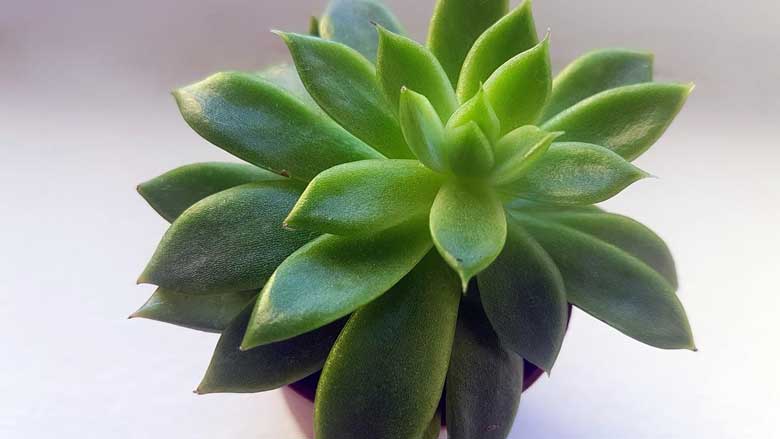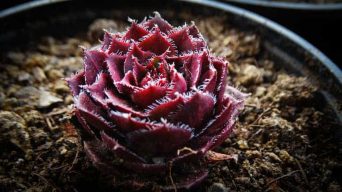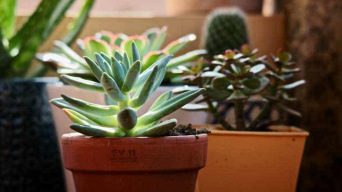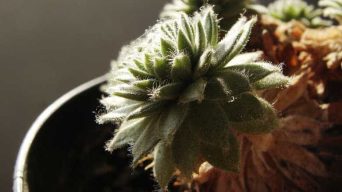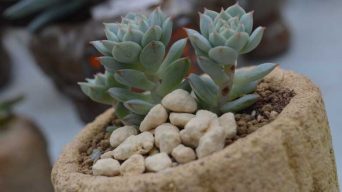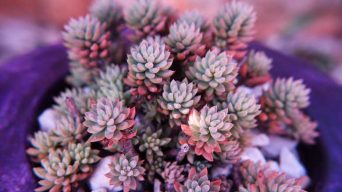Succulents are a great addition to any garden. Not only do they look beautiful, but they’re also low maintenance and drought tolerant.
They are beautiful plants that can be grown in various containers, but they do require repotting every few years.
Repotting succulents is a lot easier than you might think, but it does take some time and effort to do it properly.
If you have an overgrown succulent, repotting it will allow it to grow larger and produce many more flowers.
If you’re considering repotting your succulents, here are 13 tips that will help make repotting overgrown succulents easier!
1. Repot at the Right Time of Year
When repotting overgrown succulents, repotting during the right season is very important.
The best time to repot is at the beginning of its growing season, just as the plants begin to grow again.
Succulents are mostly dormant in the winter, so spring is the best time to repot them. On the other hand, some succulents go dormant in the summer and can, therefore, be transplanted in the fall.
Repotting during these seasons will allow the plants to become accustomed to their new pot and soil before the growing season begins.
Repotting overgrown succulents too early can cause stress and shock to a plant trying very hard to recover from repotting, so it’s best to repot at this time of year for optimal results!
2. Repot at the Right Time of Day
You should repot when the succulents are not in direct sunlight. It is best to repot during early morning or late afternoon so that they have enough hours of sun exposure without being too hot from the sun’s heat all day long.
This will also give repotting succulents enough time to dry out and re-acclimate before nightfall. If repotting succulents is done right before the sun goes down, they will not be able to dry out before evening.
This would cause repotting overgrown succulents that are too damp at night and encourage rot or mold growth.
You should also ensure not to repot succulents when it is cloudy outside. Succulent plants need direct sunlight for photosynthesis and will be stressed if they do not get enough sun exposure.
As a result, you should try to avoid repotting them on days that are cloudy or rainy. This can also encourage rot or mold growth.
When it comes to repotting overgrown succulents, timing is everything!
3. Repotting in the Right Pot Is Essential
One of the most important things to consider is putting your succulent in a pot with enough room for more soil.
If the plant has outgrown its current container, it should be moved into one with proper drainage holes and more growing space.
Generally, succulents should be repotted into a pot slightly larger than the current one.
It would be best if you used a container one size larger than the previous pot. For example, if your succulent plant was in a four-inch pot previously, it’s time to move up to a five-inch pot when repotting succulents.
Be careful not to go overboard and choose an excessively large pot, as this can damage your plant’s roots too much when you water it.
The best type of container to use for repotting is one that has a drainage hole. This allows any excess water to drain out, which will help prevent root rot and other issues from occurring in the future.
Terracotta or ceramic are the best materials for succulent pots because they are porous and allow water to drain. These materials are also excellent for the environment as they are natural and reusable.
4. Use a Fresh, Well-Draining Soil
When you’re repotting succulents, you need to use fresh soil that is well-draining.
You can use commercial succulent or cactus soil, or you can make your soil mixture. You need to use a rich potting soil that is well-draining and contains organic matter, such as peat moss.
For better drainage, you can mix in some perlite or pumice into the potting soil.
If you cannot find a commercial succulent or cactus soil mix with enough organic material for your needs, you can make up your mixture of potting soil and sand (three-quarters potting soil to one-quarter sand).
Succulents need soil that drains quickly and does not remain soggy for long periods. Succulents root best in well-draining potting soils, so it’s important to choose the right mixture when repotting your succulent plants.
Also, remember to avoid using garden soils because they tend not to drain well and may contain weed seeds, leading to problems in the future.
5. Use a Clean Working Area That Is Big Enough To Handle the Size of Your Plant
Having a clean working environment is important for succulents, especially when you are repotting them.
Moving plants around and digging into the soil with your hands makes it easy to transfer germs and dirt from old pots onto clean new ones.
This can cause rot and other problems in healthy plants that were just freshly potted up.
To prevent this from happening, you should have a clean working environment that is large enough to handle the size of your plant.
You can use a table or any other flat surface with plenty of room to work on.
If you don’t have a table, make sure to keep your plants on the floor and away from other surfaces that may be dirty or infected with diseases.
6. Use the Right Tools for Repotting Succulents
When you’re repotting succulents, using the right tools is vital. Using the wrong tool can stress out your plant or inflict damage on its roots.
A shameless hand cultivator is an excellent tool for repotting succulents. This will help you divide the roots without hurting or scratching up your hands.
A small shovel can also be used, but make sure that it has soft edges and isn’t too large; otherwise, there is a chance of damaging the plant while working with it.
A spoon, knife, or stick can help scrape away any remaining roots attached to the sides of the pot. If there isn’t much room left on the plant, don’t worry too much about this step -make sure not to damage what remains!
Don’t use your hands for removing old soil and scraping off extra roots unless necessary (if you have dirty nails/hands).
The natural oils on our fingertips could harm delicate plants like succulents by causing discoloration or death if we touch them with dirty hands.
You’ll also need a pair of sharp pruning shears or secateurs for removing dead leaves and roots from the old potting medium. When removing dead leaves, you should make clean cuts.
You’ll also need a sharp tool to break up the roots and remove them from the old potting medium. Some recommend using a screwdriver, but this can be damaging for your plant, so it is advised that you use something like an awl or small knife instead.
Finally, you’ll need a small brush to remove any old potting medium around the plant’s roots.
Keep in mind that you should always clean your tools after using them. Removing debris and dirt from the tool before use is an excellent way to prevent transferring diseases between succulent varieties or other plants.
Over time, some of this disease will inevitably transfer anyway but doing so as much as possible can help you keep a healthy collection of succulents!
7. Make Sure Your Succulent Is Healthy and Free of Pests
When planning to transplant your succulent, take a closer look at it. If you spot any pests or signs of disease on the plant, now is not the time for repotting!
An unhealthy succulent will not be able to recover in its new pot. It is always better to wait and repot a healthy succulent than risk losing your plant entirely.
Before repotting your succulent plant into fresh soil, check that there are no signs of disease on the plant.
Do this by looking closer at the leaves for
dry rot, discoloration, or yellowing. If you spot any problems with your succulent’s health, it might be best to leave them alone and wait until they are healthier before repotting.
You should also ensure no sign of pests on your succulent. Check underneath the leaves for any bugs or eggs before you repot your succulent.
If there are signs of pests, wash off your succulents with water and apply some organic pesticide to get rid of them safely.
Repotting an overgrown succulent is a great way to give it room to grow while also rejuvenating its health. If your succulent plant is looking healthy and pest-free, then it is the perfect time to repot!
8. Prune off Dead or Dried Out Leaves and Stems Before Repotting
Before starting, take a quick look at the plant and remove any dead or dried-out leaves and stems.
This will make it easier for your plant to regrow new leaves and stems in the next few weeks. You can do this with clean and sharp pruning shears or a sharp knife.
If there are any dead leaves, you can remove them by hand as well. Be careful not to damage any live parts of the plant!
Remember that succulents will regenerate new leaves from their stems over time – losing several older leaves in the process.
You can also use this opportunity to cut your plant back by a few inches if it has grown too big for its pot.
This will encourage the formation of new stems that are more compact and better suited for repotting later on (if you decide to do so).
9. Cut Back and Clean Up the Roots Before Repotting
Repotting an overgrown succulent is not difficult, but you should do some work on the roots anyhow.
Cut back and clean up the roots before repotting into fresh potting soil.
If your plant has thick or long taproots growing horizontally through the bottom of its container, trim them back so they’re flush with the rest of the root ball.
If the roots are a tangled mass that fills most of the container, use pruners to snip them back and divide them into smaller segments.
You also want to remove any debris or dead matter from the roots. If you see yellow, mushy areas on the root ball, it’s probably best to discard that section of the plant and its surrounding soil altogether.
It is also important to clean all of the old potting soil out before repotting. This will make it easier for the new soil to come in contact with all of the roots.
Remove as much old potting mix from around your plant’s root ball as possible before filling up the bottom third or half of its container with fresh, dampened potting mix.
This will help ensure that moisture penetrates every part of the root ball.
If you need to, gently tease apart roots, so the new soil penetrates all parts of the root ball before planting it in its new pot.
This will help your succulent recover faster after repotting. New roots need fresh soil if they’re going to remain healthy and strong.
10. Know When To Water Your Overgrown Succulent
Watering is an important part of the repotting process.
It is essential to thoroughly water your overgrown succulent a few days before repotting.
This will ensure that the succulent is well hydrated and more tolerant of the shock associated with repotting.
You want to allow the soil of your overgrown plant to dry out before repotting into a new container.
After you repot your succulents, do not water them immediately. Wait a few days for your succulent soil to adjust and dry out before rewatering.
If you water too soon, it may throw off balance between new potting mix and old soil, possibly leaving pockets of water in the soil that could lead to root rot over time.
Allow at least a week for the soil to dry out completely before watering again.
11. Keep Succulents With Similar Needs Together When Repotting
When you are repotting your succulents, you should consider the growing conditions that they will need.
For example, if you have two different types of succulents that require different conditions, they should not be repotted together.
This will help you to avoid under or overwatering your succulents.
You will need to consider the type of succulent that you are repotting, how large it is, and where the plant will be positioned in your home or garden.
12. Place Your Succulent in a Bright Location, but Out of Direct Sunlight
After repotting your succulent, place the plant in a bright location but not in direct sunlight.
Too much sunlight can burn the leaves and dry out your plant.
Although succulents need light, they do not like the direct sun as it will scorch their delicate leaves.
Succulents need about six to eight hours of bright light per day if you want them to thrive.
The best place for your repotted succulent is next to a south-facing window or in an area that receives indirect sunlight.
Only repot when they are receiving adequate lighting after they have been moved to a new pot.
13. Give It Time To Adjust To Its New Environment
Succulents are particularly vulnerable to transplant shock when they get repotted, so be patient with them.
You might not see any new growth or blooms for some time after repotting your succulent.
It takes time for the plant’s roots to adjust and recover from the stress of being uprooted.
The plant will stay small and stressed for the first few months, but it should recover over time.
If you provide the proper care, your succulents should look better than ever in just a few months.
Final Thoughts
Repotting overgrown succulents can be easy and fun. There are many tips that you should follow to ensure the best results.
Knowing when you need to repot succulents is important. Repotting them at the right time will help keep your succulents healthy and growing.
Remember, succulent plants need space for their roots and an appropriate soil mix with ample drainage and nutrients.
Ensuring your plant is properly cared for will help it stay healthy and beautiful.

